ATV-2 Reentry +3 months, ATV-3 launch -6 months: Day 17 of Launch Campaign
The next update from ESA’s Charlotte Beskow in Kourou – Ed.
It has been a busy week! The launch campaign is now in Day 17 (of 180 days) — as you can imagine, preparing a 20-tonne vehicle means there is a lot of logistics work to be carried out before you can really start. We have the opportunity to store some items here at Centre Spatiale Guyanais (CSG) in Kourou between campaigns, but a lot of items are shipped across the Atlantic at the start of the campaign. So, the week was mostly dedicated to mechanical work.
Who works in the space industry?
The obvious answer is technicians, engineers and astronauts. The less obvious answer is… everyone! That includes transport organisers, cleaners, forklift operators, secretaries, canteen staff (really important!), truck drivers, crane operators, air-conditioning technicians, and so on and so forth. The images below highlight this. These people are equally important every day of the ATV launch campaign since there are always things to be moved, either internally on site or to/from the airport/port.
On 25 August, the ship carrying ATV-3 arrived in Kourou harbour. I saw it entering the river mouth during lunch time and, like a few others, ran down to have a closer look.
The Astrium people were there before me and happily waved to those on board. We still had to wait several hours for the tide levels to allow unloading. At 15:00, with the sun beating down on us, we entered the hold of the ship to have a look at our precious cargo. If it was hot outside (and it was!), it was nothing compared to the temperature inside, in particular on the staircase leading to the hold. I could feel my face going beet red with the heat and pitied those who had to endure these conditions all the time.
It is very important to keep the equipment at a suitable temperature (around 21C) throughout the entire journey so the most temperature-sensitive ATV items are transported in special containers equipped with cooling units.
The wait for the tide felt very long in the heat — so after a while I opted to head back to the office and cool my head.
By 17:30, off-loading had started. Smaller items came off first, but we still had to wait for the conditions to be right for the main items.
Then the bigger items came rolling off, triggering a lot of activity amongst the spectators…
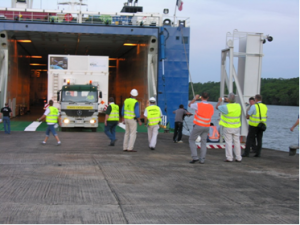
Then the bigger items came rolling off, triggering a lot of activity amongst the spectator. Credit: ESA
And finally Edoardo itself (himself?) appeared, pulled very carefully by a very big truck…
Getting the stuff off the boat was just the start. We then had to move everything into the controlled storage areas at CSG as quickly as possible. This is no easy task. The equipment takes a lot of space, is sensitive, and needs to be carefully manipulated with cranes into what we call the airlock. The airlock is the area that separates the ‘dirty’ outside world from the ‘clean’ inside world where the pre-launch preparations are made.
So how is this done? Well, first you make sure the airlock is clean and that everything is ready. Then you open the big door, roll in the truck, off-load your items, get the truck out as soon as possible and then shut the door.
Then you shift everything out of the way and get ready to move in the next items.
Apart from those directly involved in the transporting — and those watching their cargo arrive — there is also a group of important people: the cleaners, who sweep the floor to keep conditions as clean as possible… and so on until everything is inside.
Then comes the task of shifting items into the clean room. As anyone who has moved house knows, this is a task that requires a lot of thought and planning so that the right items arrive at the right time.
In parallel you need to keep track of where you put the things that you temporarily move out of the way…
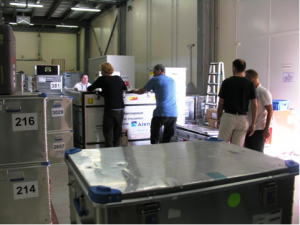
Now if we move this one over there, and that one over on the other side, we should be able to get to the box we need... Credit: ESA
ATV is composed of several parts, but in general we speak only of two: the spacecraft (S/C) and the integrated cargo carrier (ICC). The spacecraft is essentially the part that does the ‘flying’ — i.e. it contains the engines, computers, guidance systems, fuel reservoirs, etc.
The cargo carrier is what the name implies: it contains an unpressurised part (where the water, gas tanks and the Russian fuel tanks are located) and a pressurised part — sort of like an aircraft cabin (but less luxurious) — that the crew can enter.
This part is equipped with special shelves (racks) where the dry cargo is stored. At the front of the ICC, we have the Russian docking system. This allows us to dock to the Russian segment of the International Space Station.
On the Monday (29 Aug), we moved the spacecraft to its integration stand and prepared the ICC for the next step of the work.
The following days were spent unpacking various items we need for the testing.
The Electrical Ground Support Equipment (EGSE) and the Fluidic Ground Support Equipment (FGSE) all had to be unpacked, assembled and tested.
In addition, Astrium (the ATV prime contractor) erected a scaffolding platform, which will safely allow access to all levels of the S/C — because there are a lot of things to be done and, as you can see, ATV is pretty big!
This is a **big** task and took most of the week. The result was successful — even if these photos leave a bit to be desired. 🙂
We finished the week with an important meeting, checking to see if we are ready to electrically connect the two parts of the ATV and then connect both of them to the EGSE in order to perform the Transport Integrity Check, i.e. to see if Edoardo ‘survived’ the Atlantic crossing intact. This will continue on Monday (5 Sep), and on Tuesday the TIC will start.
More news on this next week!
— Charlotte



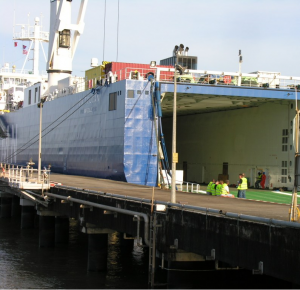
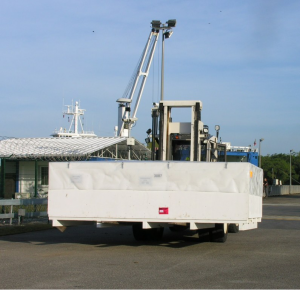
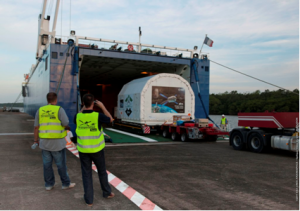
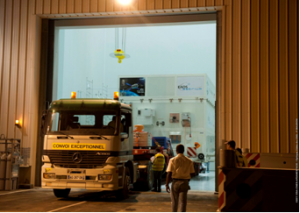

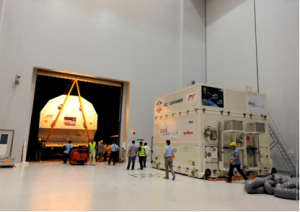
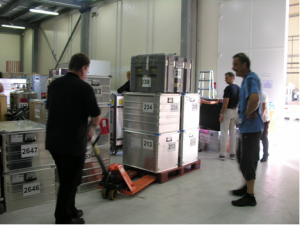
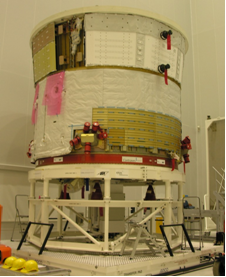
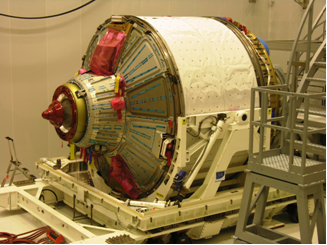
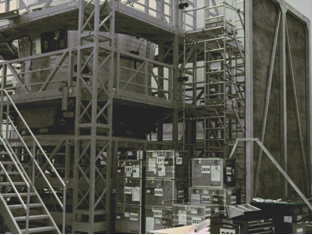
 Automated Transfer Vehicle page
Automated Transfer Vehicle page ATV blog archive
ATV blog archive
 NASA Orion page
NASA Orion page NASA Artemis
NASA Artemis Airbus Orion page
Airbus Orion page
Discussion: no comments